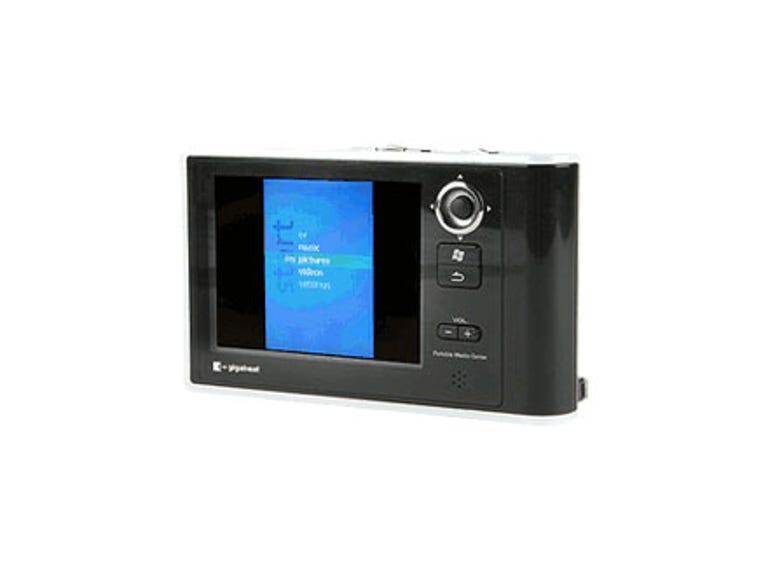 Why You Can Trust CNET
Why You Can Trust CNET Toshiba gigabeat V30 review: Toshiba gigabeat V30
The V30 puts the focus squarely on watching and listening to your files, with a noticeably short features list and a beefed-up battery life.
Following swiftly behind Toshiba's gigabeat S series of media players is the V30, which, like the S30 before it, is a 30GB model that runs the portable edition of Windows Media Center.
The Good
The Bad
The Bottom Line
Design
The V30 has a horizontal orientation, making it better suited to video viewing than the more music-focused S30. While the display is larger at 3.5 inches, it retains the 320 x 240-pixel resolution, meaning the screen looks less sharp and fluid than that of its predecessor.
Measuring 76mm by 124mm by 18mm and weighing in at 225 grams, the V30 is not a device to force into the hip pocket of your skinny-fit jeans, but it's thin enough to slip in the front of your bag or a jacket pocket.
The S30's controls consisted of a lovely cross-shaped navigation button and a line of subdued silver circles along the side of the device. The buttons on the V30 are a little more fussy. You navigate the menus by moving a small, recessed thumb toggle at the top right -- pressing it in will select items on the screen. Below the toggle are two rectangular keys: one launches the Windows Start menu, and the other returns to the previous menu layer. Rounding out the keys on the front of the V30 are the dedicated volume keys, which sit above a teeny speaker and are curiously small.
On the top of the player are the play/pause and track-skip buttons, and a two-way slider that functions as both hold switch and power button. We would have preferred it if the keys controlling music playback had been placed further to the right, as their location makes it difficult to keep your thumb on the toggle while controlling them.
Windows Media Center users will recognise the interface, which is a scaled-down version of the desktop software. The text-based menus are a cinch to navigate, and if you own a media centre PC, the device will slot nicely into that set-up. (Recorded TV shows can be transferred easily without requiring conversion, and programs retain their file information.)
Features
The V30's feature list is notable for its brevity -- the FM tuner seen in the S30 has been ditched, and there are no voice-recording capabilities. This player is for those who like to watch, which is reflected in its vastly beefed-up battery life -- Toshiba claims the lithium-ion cell will keep on chugging for eight hours of video viewing or 30 hours of music.
One limitation puzzled us greatly -- the inability to charge the player via USB. And that's not all -- on the back of the unit is a large sticker warning that the V30 cannot be charged (using the AC adaptor) while it is connected to your computer via USB. This restriction is an annoyance for those whose routine involves a quick charge, sync and go.
The supported file formats list is predictably Microsoftian. For audio, you've got WMA, (including protected WMAs bought from online music retailers), WAV and, of course, MP3. Video support is limited to WMV format, so if you've amassed a heap of videos in AVI or MPEG-4 format, you'll need to get started on a serious session of file conversion. You can also store and view JPEG images on the V30, and a TV-out cable is included. Perfect for those occasions when you want to share embarrassing photos, and a 3.5-inch display just doesn't make things humiliating enough.
With all the paring back of features compared with the S30, it was good to see the addition of a speaker.
Performance
In testing the V30, we couldn't help but think wistfully of the S30, which pleased us greatly with an elegant design and simple menus. While the V30 shared the easy-to-use Portable Media Center interface, we did find ourselves feeling let down by a comparatively grainy screen, that tiny thumb toggle, and the lack of extra features.
We predicted that the speaker would deliver second-rate sound, due to its size and placement. We were wrong. Audio emanating from those teeny holes was clearer than anticipated, although when volume is cranked, you'll feel some significant vibrations shaking the back of the unit.
The number one improvement on the S30 was in the battery life, which soared beyond its predecessor's specs to land at over six hours of video playback. If you've ever suffered through a long-haul flight watching decade-old sitcoms and films that tanked at the box office, you will surely appreciate the ability to tote several hours' worth of video entertainment in your carry-on luggage.
The V30 came close to being a very good portable media device, but a few issues held it back from greatness, especially in light of the fab S30. What we'd love is to see some sort of V30/S30 hybrid -- the form factor and FM radio of the S30, with the battery grunt and speaker of the V30. We can but dream for now, and if pressed to choose between the two, would pick the S30. It just doesn't seem worth it to shell out extra for fewer features, even given that gloriously extended battery life.


